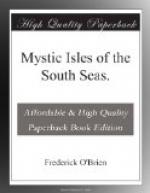“My word,” said Stevens, a London stockbroker, here to rehabilitate a broken corporation, “if we English had this place, wouldn’t there be a cleaning up! We’d build it solid and sanitary, and have proper rules to make the bally natives stand around.”
The practical British would that. They have done so in a dozen of their far-flung colonies I hare been in, from Singapore to Barbadoes, though they have failed utterly in Jamaica. Yet, I am at first sight, of the mind that only the Spanish would have kept, after decades of administration, as much of the simple beauty of Papeete as have the Gauls. True, the streets are a litter, the Government almost unseen as to modern uplift, the natives are indolent and life moves without bustle or goal. The republic is content to keep the peace, to sell its wares, to teach its tongue, and to let the gentle Tahitian hold to his island ways, now that his race dies rapidly in the spiritual atmosphere so murderous to natural, non-immunized souls and bodies.
Many streets and roads are shaded by spreading mango-trees, a fruit brought in the sixties from Brazil, and perfected in size and flavor here by the patient efforts of French gardeners and priests. The trees along the town ways are splendid, umbrageous masses of dark foliage whose golden crops fall upon the roadways, and which have been so chosen that though they are seasonal, the round mango is succeeded by the golden egg, and that by a small purple sort, while the large, long variety continues most of the year. Monseigneur Jaussen, the Catholic bishop who wrote the accepted grammar and dictionary of the Tahitian language, evolved a delicious, large mango, with a long, thin stone very different from the usual seed, which occupies most of the circumference of this slightly acidulous, most luscious of tropical fruits. Often the pave is a spatter of the fallen mangos, its slippery condition of no import to the barefooted Tahitian, but to the shod a cause of sudden, strange gyrations and gestures, and of irreverence toward the Deity.
Scores of varieties of fruits and flowers, shade-trees, and ornamental plants were brought to Tahiti by ship commanders, missionaries, officials, and traders, in the last hundred years, while many of the indigenous growths have been transplanted to other islands and continents by those whose interests were in them. The Mutiny of the Bounty, perhaps the most romantic incident of these South Seas, was the result of an effort to transport breadfruit-tree shoots from Tahiti to the West Indies. It is a beautiful trait in humankind, which, maybe, designing nature has endowed us with to spread her manifold creations, that even the most selfish of men delight in planting in new environments exotic seeds and plants, and in enriching the fauna of faraway islands with strange animals and insects. The pepper- and the gum-tree that make southern California’s desert a bower, the oranges and lemons there which send a million golden trophies to less-favored peoples, are the flora of distant climes. Since the days of the white discoverers, adventurers and priests, fighting men and puritans, have added to the earth’s treasury in Tahiti and all these islands.




